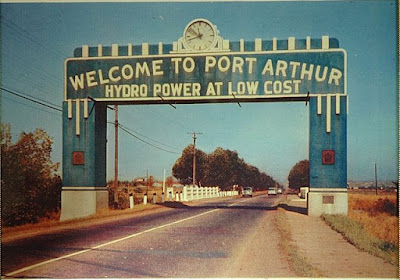More
fascination with Canada's participation in the British Commonwealth
Air Training Plan (BCATP). In my previous lengthy post (see post
below this one), I show how to access the daily reports for the
Elementary Flight Training Schools (EFTS). I also mention that names
are scattered throughout the reports for EFTS No. 2 at Thunder Bay.
We are reminded that the city was formerly the friendly rival twins
of Fort William (location of the school) and Port Arthur ... usually,
but not always, friendly.
For the record and besides the flight training school, the war effort
in this locale included Port Arthur Shipbuilding and Canadian Car &
Foundry in Fort William.
Back
in Second World War days, they were smallish towns. Interaction
between the school and civilians was immediate and often intense.
After their flying hours, ground lectures, and homework, the flight
trainees had a variety of sports programs as well as a fair amount of
leisure time, so they became familiar with the towns. Outside labour
was constantly necessary for the buildings and mechanical
maintenance, for provisions and care of the resident air force
officers and changing groups of trainees. Tours of the facility were
arranged for a stream of visitors.
Random
entries from the commanding officer's daily reports in the summer of
1941 recall places and businesses from the past:
The
Royal Edward Hotel saw its share of beverage consumption by
enthusiastic airmen on passes. The Italian Hall was one of the
few other venues for social mixing. Boulevard Lake was used in
a program of Tuesday night swimming –
in the warmer months! Otherwise it was the YMCA. The local
IODE (Imperial Order Daughters of the Empire) was quick to
organize regular events such as on-site dances, and as previously
mentioned, the Public Library donated books and bookshelves to
the school.
Fryer
Studio came regularly to take photographs; they donated the Fryer
Memorial Cup for flying competition among the course students.
McKellar Hospital tended to an assortment of minor or major
casualties from the flyers, plus the occasional unmentionable virus.
Actually, an outbreak of mumps caused real fear and concern. Mahon
Electric serviced the school buildings; Gibson-Elm
did interior painting.
Crawley &
McCracken were
early food
caterers who did not work out for unspecified reasons.
Burney's Taxi
(special rates for
dance nights) delivered
many a
pie-eyed trainee desperate
to reach
the school before
night curfew.
It
was up to civilian manager Hector Dougall to handle the construction
contracts, general supplies, office services, and maintenance of
aircraft and equipment. Claydon Construction was frequently
mentioned with regard to construction of new runways and ongoing
building needs. EA Bell was another contractor, for example,
securing the "gasoline hose pits." Ditto Mr
Kerr of Warren
Paving Co.
Both city mayors (Charles Cox, Port Arthur; Chisholm
Ross, Fort William) were castigated at one time or another for
arbitrarily supplementing the itineraries of important visitors, thus
spoiling a strict military schedule.
Senator
Norman Paterson donated rifles for the school's rifle
range, and came by several times over the duration for a chat; Judge
McComber along with Mr. Elliott "of the Court House"
and Mr. Boyd were given a tour. Orville Wieben of the
Lakehead Flying Club lent the use of his facilities when flooding
caused delays in the assembling of Oxford aircraft. Alex Sinclair
was the principal of Port Arthur Collegiate Institute; he came
to discuss his school's air cadet program with RCAF personnel.
HRH
Prince
George, Duke of Kent, was not the only royal
dignitary to visit.
In late August 1941,
Canada's Governor
General, the
Earl of
Athlone and his wife
Princess Alice
arrived by train for
one of those highly organized tours coordinated by various
interested parties. The
daily report relates
the unhappiness of the
school's commanding
officer with the
organizing elements:
This meeting was at times quite stormy as the mayor and his committee had, without consulting the Services, indicated that a guard of honor would be supplied at the railway depot. Furthermore, although this visit of the Governor General was to inspect war industries at the Lakehead, the civil authorities had endeavored to increase his itinerary by omitting to mention war industries such as the 102nd Training Centre, but instead had included the mountain view from the first ledge of Mt. McKay and such like. This is recorded in this Diary because it is the normal idea adopted by the local authorities here, that the local view for an item of inspection is far more important than Units of this nature and other centres of equal importance.
(The
102nd Training Centre comprised the EFTS complex.)
 |
| Mount McKay, Fort William |
I
must say the daily reports are also contain names of basic training
students, flying conditions, and RCAF personnel. Who went on to
advanced flight school, who "washed out," who had accidents
with the airplanes ... it's all there in No. 2 EFTS. Might be worth
another go at extracting. I see there are also daily reports on the
same microfilm reel C-12336 for:
Malton,
Ontario (No. 1 EFTS)
London,
Ontario (No. 3 EFTS)
Boundary
Bay/Sea Island, Vancouver (No. 8 EFTS)
Stevenson
Field, Winnipeg (No. 14 EFTS)
Portage
la Prairie, Manitoba (No. 14 EFTS)
Edmonton,
Alberta (No. 16 EFTS)
Caron,
Saskatchewan (No. 18 EFTS)
Chatham,
New Brunswick (No. 21 EFTS)
L'Ancienne-Lorette,
Quebec (No. 22 EFTS)
Pearce,
Alberta (No. 36 EFTS)
Windsor
Mills, Quebec (No. 4 EFTS)
Prince
Albert, Saskatchewan (No. 6 EFTS)
©
2017 Brenda Dougall Merriman






